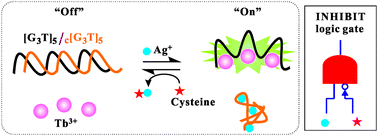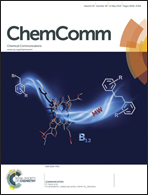DNA-based sensitization of Tb3+ luminescence regulated by Ag+ and cysteine: use as a logic gate and a H2O2 sensor†
Abstract
A simple and facile strategy was developed for regulating the luminescence of Tb3+ sensitized by DNA, in which Ag+ and cysteine (Cys) act as activators. The Ag+/Cys-mediated reversible luminescence changes in the Tb3+–DNA sensing system enabled the design of a DNA INHIBIT logic gate and a H2O2 sensor in a time-resolved luminescence format.


 Please wait while we load your content...
Please wait while we load your content...